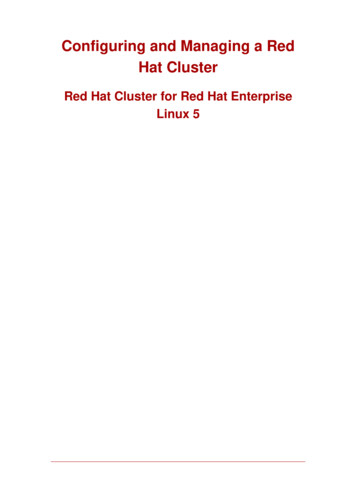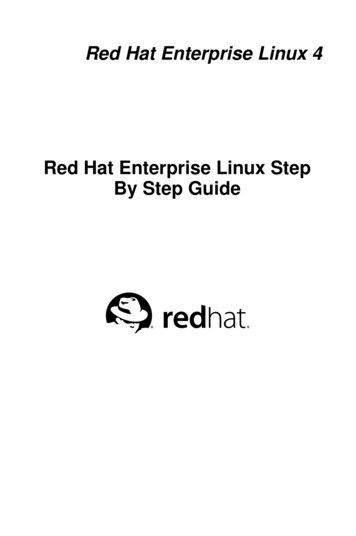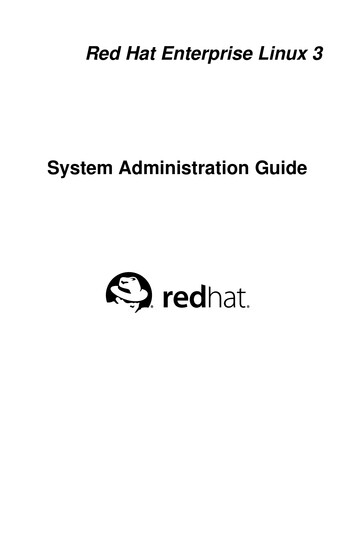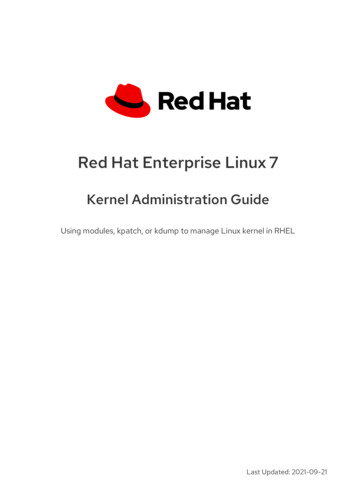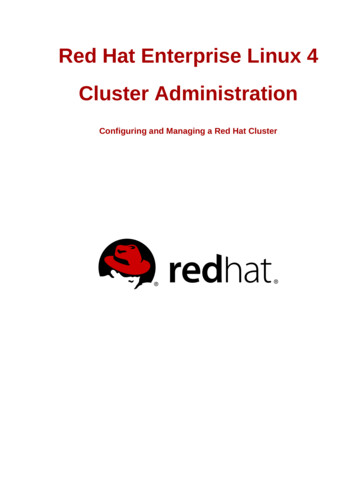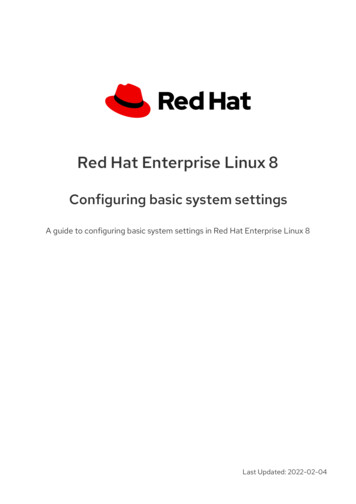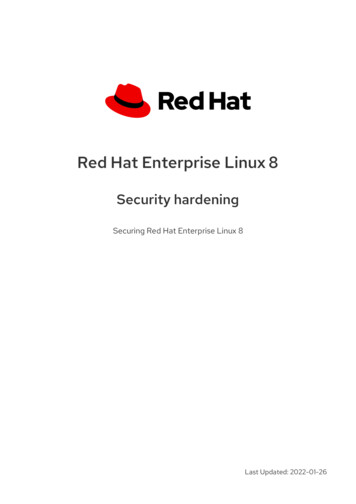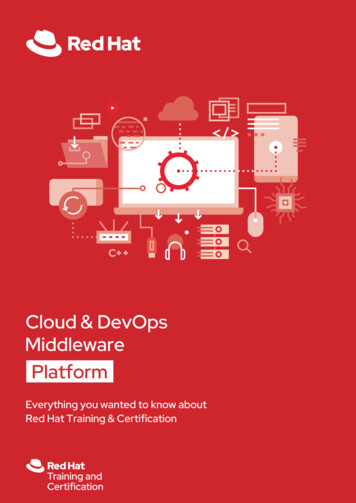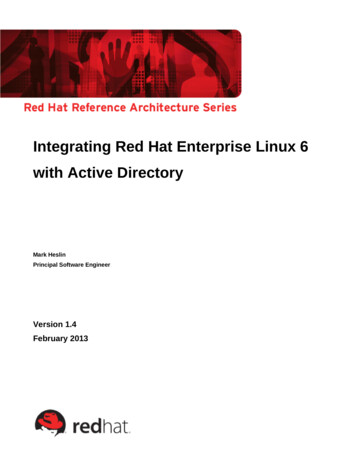
Transcription
Integrating Red Hat Enterprise Linux 6with Active DirectoryMark HeslinPrincipal Software EngineerVersion 1.4February 2013
1801 Varsity Drive Raleigh NC 27606-2072 USAPhone: 1 919 754 3700Phone: 888 733 4281Fax: 1 919 754 3701PO Box 13588Research Triangle Park NC 27709 USALinux is a registered trademark of Linus Torvalds. Red Hat, Red Hat Enterprise Linux and the Red Hat"Shadowman" logo are registered trademarks of Red Hat, Inc. in the United States and othercountries.Microsoft and Windows are U.S. registered trademarks of Microsoft Corporation.UNIX is a registered trademark of The Open Group.Intel, the Intel logo and Xeon are registered trademarks of Intel Corporation or its subsidiaries in theUnited States and other countries.All other trademarks referenced herein are the property of their respective owners. 2012 by Red Hat, Inc. This material may be distributed only subject to the terms and conditions setforth in the Open Publication License, V1.0 or later (the latest version is presently available athttp://www.opencontent.org/openpub/).The information contained herein is subject to change without notice. Red Hat, Inc. shall not be liablefor technical or editorial errors or omissions contained herein.Distribution of modified versions of this document is prohibited without the explicit permission of RedHat Inc.Distribution of this work or derivative of this work in any standard (paper) book form for commercialpurposes is prohibited unless prior permission is obtained from Red Hat Inc.The GPG fingerprint of the security@redhat.com key is:CA 20 86 86 2B D6 9D FC 65 F6 EC C4 21 91 80 CD DB 42 A6 0ESend feedback to -feedback@redhat.com
Table of Contents1 Executive Summary. 12 Component Overview. 22.1 Red Hat Enterprise Linux 6. 22.2 Windows Server 2008 R2. 32.3 Active Directory Domain Services (AD DS). 32.4 Identity Management (IdM) in Red Hat Enterprise Linux (RHEL). 32.5 Samba. 42.6 SMB/CIFS. 42.7 Winbind. 42.8 Kerberos. 62.9 Lightweight Directory Access Protocol (LDAP). 62.10 System Security Services Daemon (SSSD). 72.11 Domain Name System (DNS). 72.12 Network Time Protocol (NTP). 72.13 Name Service Switch (NSS). 73 Considerations. 83.1 Non-technical Considerations. 83.1.1 Organizational Alignment. 83.1.2 Expertise Levels. 83.1.3 Scope/Complexity. 93.1.4 Prototype . 93.1.5 Project Deployment. 93.2 Technical Considerations. 93.2.1 File Sharing. 93.2.2 Login Access. 93.2.3 Active Directory ID Attributes. 103.2.4 Enumeration. 103.2.5 LDAP Referrals. 103.2.6 Winbind Backends. 113.2.7 Services Integration. 133.2.8 Log Files. 13refarch-feedback@redhat.comiiiwww.redhat.com
4 Configurations. 144.1 Overview. 144.2 Configuration Feature Comparisons. 154.3 Selecting a Configuration. 185 Deployment Prerequisites. 195.1 Deploy Windows 2008 Server R2. 195.2 Configure Active Directory Domain Services. 195.3 Deploy Red Hat Enterprise Linux 6. 205.4 Configure SELinux Security Parameters. 205.5 Install/Configure Samba. 215.6 Synchronize Time Services. 215.7 Configure DNS. 225.8 Install/Configure Kerberos Client. 235.9 Install oddjob-mkhomedir. 246 Recommended Configurations. 256.1 Configuration 1 - Samba/Winbind (idmap rid). 266.1.1 Configuration Summary. 266.1.2 Systems Overview. 276.1.3 Authentication and ID Components. 276.1.4 Integration Tasks. 286.1.5 Verification of Services. 386.2 Configuration 2 – Samba/Winbind (idmap ad). 416.2.1 Configuration Summary. 416.2.2 Systems Overview. 426.2.3 Authentication and ID Components. 426.2.4 Integration Tasks. 436.2.5 Verification of Services. 536.3 Configuration 3 – SSSD/Kerberos/LDAP. 566.3.1 Configuration Summary. 566.3.2 Systems Overview. 576.3.3 Authentication and ID Components. 576.3.4 Integration Tasks. 586.3.5 Verification of Services. 686.4 Configuration 4 – Kerberos/LDAP. 706.4.1 Configuration Summary. 70www.redhat.comivrefarch-feedback@redhat.com
6.4.2 Systems Overview. 716.4.3 Authentication and ID Components. 716.4.4 Integration Tasks. 726.4.5 Verification of Services. 807 Conclusion. 82Appendix A: References. 83Appendix B: Glossary. 85Appendix C: Winbind Backend Reference. 92Appendix D: Active Directory Domain Services – Configuration Summary. 100Appendix E: Active Directory User Account Mappings. 110Appendix F: Command Reference – net, wbinfo. 111Appendix G: Reference Architecture Configurations. 113Appendix H: Deployment and Integration Checklist – Configuration 1(Samba/Winbind - idmap rid). 117Appendix I: Deployment and Integration Checklist – Configuration 2(Samba/Winbind - idmap ad). 118Appendix J: Deployment and Integration Checklist – Configuration 3(SSSD/Kerberos/LDAP). 119Appendix K: Deployment and Integration Checklist – Configuration 4(Kerberos/LDAP). 120refarch-feedback@redhat.comvwww.redhat.com
1 Executive SummaryIn many organizations, system administrators encounter the need to integrate Linux systemsinto their existing Microsoft Windows Active Directory domain environments. There is a vastarray of published material available. How does one begin to sort through this material tobetter understand and determine the best solution to deploy for their specific environment?On the surface, the world of Linux and Windows interoperability appears deceptively simple.However, after closer examination, initial optimism gives way to the realization that there isan overwhelming number of components, configurations and integration options available.The intent of this reference architecture is to provide guidelines to simplify and assist in theselection, deployment and integration process.This paper details the components, considerations and configurations available for selecting,deploying and integrating Red Hat Enterprise Linux 6 into Windows Active Directory domains.Basic concepts are introduced, deployment and integration tasks outlined, best practices andguidelines provided throughout.To facilitate the selection process, a decision tree has been provided to guide the readertowards one of four recommended configurations. All deployment prerequisites must becompleted before proceeding with the integration tasks.Red Hat Enterprise Linux is a high-performing operating system that has deliveredoutstanding value to IT environments for nearly a decade. As the world’s most trusted ITplatform, Red Hat Enterprise Linux has been deployed in mission-critical applications atglobal stock exchanges, financial institutions, leading telcos, and animation studios. It alsopowers the websites of some of the most recognizable global retail brands.Red Hat Enterprise Linux 6 offers unmatched reliability, performance, security, simplifiedmanagement capabilities and costs savings. The included interoperability features are basedon industry-proven standards and capabilities. For organizations looking to integrate Linuxsystems into Windows Active Directory domains, Red Hat Enterprise Linux 6 remains theplatform of choice.This document does not require extensive Red Hat Enterprise Linux experience but thereader is expected to have a working knowledge of Windows 2008 Server administrationconcepts. As a convenience, a glossary is provided in Appendix B: Glossary and can beconsulted for unfamiliar terms or m
2 Component OverviewThis section provides detailed descriptions on the various components. A solid understandingof each component and it's relevance is essential to deploying a successful integrationproject. Depending on which of the actual configurations is selected, some components mayor may not be implemented.2.1 Red Hat Enterprise Linux 6Red Hat Enterprise Linux 6, the latest release of Red Hat's trusted datacenter platform,delivers advances in application performance, scalability, and security. With Red HatEnterprise Linux 6, physical, virtual and cloud computing resources can be deployed withinthe data center. Red Hat Enterprise Linux 6.2 provides the following features and capabilities:Reliability, Availability, and Security (RAS): More sockets, more cores, more threads, and more memoryRAS hardware-based hot add of CPUs and memory is enabledMemory pages with errors can be declared as “poisoned” and can be avoidedFile Systems: ext4 is the default file system and scales to 16TBXFS is available as an add-on and can scale to 100TBFuse allows file systems to run in user space allowing testing and development onnewer fuse-based file systems (such as cloud file systems)High Availability: Extends the current clustering solution to the virtual environment allowing for highavailability of virtual machines and applications running inside those virtual machinesEnables NFSv4 resource agent monitoringIntroduction of Cluster Configuration System (CCS). CCS is a command line tool thatallows for complete CLI administration of Red Hat's High Availability Add-OnResource Management: cgroups organize system tasks so that they can be tracked and other system servicescan control the resources that cgroup tasks may consumecpuset applies CPU resource limits to cgroups, allowing processing performance to beallocated to tasksThere are many other feature enhancements to Red Hat Enterprise Linux 6. Please see theRed Hat website for more .com
2.2 Windows Server 2008 R2Windows Server 2008 R2 is Microsoft's enterprise operating system for businesses andprovides features for virtualization, power savings, manageability and mobile access.Windows Server 2008 R2 is available in several editions – Foundation, Standard, Enterprise,Datacenter, Web and HPC (High Performance Computing). Windows Server 2008 R2Enterprise Edition is used for the configurations described in this reference architecture.2.3 Active Directory Domain Services (AD DS)Active Directory Domain Services is a suite of directory services developed by Microsoft.Active Directory utilizes customized versions of industry standard protocols including: Kerberos Domain Name System (DNS) Lightweight Directory Access Protocol (LDAP)Active Directory allows Windows system administrators to securely manage directory objectsfrom a scalable, centralized database infrastructure. Directory objects (users, systems,groups, printers, applications) are stored in a hierarchy consisting of nodes, trees, forests anddomains.Prior to Windows Server 2008 R2, Active Directory Domain Services was known as ActiveDirectory. Active Directory Domain Services is included with Windows Server 2008 R2.2.4 Identity Management (IdM) in Red Hat EnterpriseLinux (RHEL)Red Hat Identity Management (IdM) in RHEL is a domain controller for Linux and UNIXservers that uses native Linux tools. Similar to Active Directory, Identity Managementprovides centralized management of identity stores, authentication and authorization policies.Identity Management defines a domain, with servers and clients who share centrallymanaged services, like Kerberos and DNS. Although centralized applications to manageidentity, policy and authorization are not new, Identity Management is one of the only optionsthat supports Linux/Unix domains.Identity Management provides a unifying interface for standards-based, common networkservices, including PAM, LDAP, Kerberos, DNS, NTP, and certificate services, and allowsRed Hat Enterprise Linux systems to serve as domain controllers.Currently, Red Hat Identity Management in RHEL does not provide support for full ActiveDirectory domain trusts, therefore it's use is considered out of scope for the configurationsdetailed within this document. For further information on Identity Management please consultthe references found in Appendix A: com
2.5 SambaSamba is an open source suite of programs that can be installed on Red Hat Enterprise Linux6 systems to provide file and print services to Microsoft Windows clients.Samba provides two daemons that run on a Red Hat Enterprise Linux 6 system: smbd (primary daemon providing file and print services to clients via SMB) nmbd (NetBIOS name server - not required for integration purposes)When combined with the reliability and simplified management capabilities of Red HatEnterprise Linux 6, Samba is the application of choice for providing file and print sharing toWindows clients. Samba version 3.5 is used in the Samba based configurations detailedwithin this reference architecture.2.6 SMB/CIFSBoth Server Message Block (SMB) and Common Internet File System (CIFS) are networkprotocols developed to facilitate client to server communications for file and print services.The SMB protocol was originally developed by IBM and later extended by Microsoft as theCIFS protocol.Samba supports both the SMB and CIFS protocols with SMB provided for client connectionsto older, legacy Windows servers (Windows 2000 or earlier). The terms SMB and CIFS areoften interchanged but from a functional perspective, both are protocols used by Samba.2.7 WinbindWinbind is a component of the Samba suite of programs that allows for unified user logon.winbind uses an implementation of Microsoft RPC (Remote Procedure Calls), PAM(Pluggable Authentication Modules), and Red Hat Enterprise Linux 6 nsswitch (Name ServiceSwitch) to allow Windows Active Directory Domain Services users to appear and operate aslocal users on a Red Hat Enterprise Linux machine. Winbind minimizes the need for systemadministrators to manage separate user accounts on both the Red Hat Enterprise Linux 6 andWindows Server 2008 R2 environments. winbind provides three separate functions: Authentication of user credentials (via PAM). This makes it possible to log onto a RedHat Enterprise Linux 6 system using Active Directory user accounts. Authentication isresponsible for identifying “Who” a user claims to be. ID Tracking/Name Resolution via nsswitch (NSS). The nsswitch service allows userand system information to be obtained from different database services such as LDAPor NIS. ID Tracking/Name Resolution is responsible for determining “Where” useridentities are found. ID Mapping represents the mapping between Red Hat Enterprise Linux 6 user (UID),group (GID), and Windows Server 2008 R2 security (SID) IDs. ID Mappings arehandled through an idmap “backend” that is responsible for tracking “What” ID's usersare known by in both operating system t.com
Figure 2.6: Winbind Authentication, ID Components and Backends represents therelationship between Winbind and Active Directory:Figure 2.6: Winbind Authentication, ID Components and BackendsWinbind idmap “backends” are one of the most commonly misunderstood components inSamba. Since Winbind provides a number of different “backends” and each manages IDMappings differently, it is useful to classify them as follows: Allocating - “Read-Writeable” backends that store ID Mappings in a local databasefile on the Red Hat Enterprise Linux 6 system(s). Algorithmic - “Read-Only” backends that calculate ID Mappings on demand andprovide consistent ID Mappings across each Red Hat Enterprise Linux 6 system. Assigned - “Read-Only” backends that use ID Mappings pre-configured within ActiveDirectory.Selecting a Winbind “backend” is also dependent on factors such as: Whether or not Active Directory schema modifications are permitted Preferred location of ID Mappings Number of Red Hat Enterprise Linux 6 systems Number of nodes in the Active Directory forest Use of LDAPUnderstanding Winbind backends is essential when selecting a Samba based configuration.Section 3.2.6 Winbind Backends provides a comparative overview of each of the Winbindbackends currently available under Red Hat Enterprise Linux 6.refarch-feedback@redhat.com5www.redhat.com
2.8 KerberosDeveloped at the Massachusetts Institute of Technology (MIT), Kerberos is a networkauthentication protocol that uses symmetric key cryptography to provide highly secureauthentication between client and server applications. Both Red Hat Enterprise Linux 6 andWindows server 2008 R2 are based on the current release of Kerberos - version 5. Theconfigurations described within this paper are based on Kerberos version 5.Kerberos operates on the basis of “tickets” that are granted by a trusted third-party called akey distribution center (KDC). The KDC maintains a secure database of secret keys that areknown only to the KDC itself and the client requesting a ticket. Tickets have a configurableexpiration date and must be refreshed by the client on a regular basis.Kerberos authentication is significantly safer than normal password-based authenticationbecause passwords are never sent over the network - even when services are accessed onother machines.2.9 Lightweight Directory Access Protocol (LDAP)The Lightweight Directory Access Protocol (LDAP) is a set of open protocols used toaccess centrally stored information over a network. It is based on the X.500 standard fordirectory sharing, but is less complex and resource-intensive. For this reason, LDAP issometimes referred to as "X.500 Lite." The X.500 standard is a directory that containshierarchical and categorized information, which could include information such as names,addresses, and phone numbers.Like X.500, LDAP organizes information in a hierarchy based on the use of directories. Thesedirectories can store a variety of information and can even be used in a manner similar to theNetwork Information Service (NIS), enabling anyone to access their account from anymachine on the LDAP enabled network.In many cases, LDAP is used as a virtual phone directory, allowing users to easily accesscontact information for other users. However, LDAP is much more flexible and capable ofreferring a query to other LDAP servers throughout the world, providing an ad-hoc globalrepository of information. Currently, LDAP is more commonly used within individualorganizations, like universities, government departments, and private companies.LDAP is a client/server system. The server can use a variety of databases to store adirectory, each optimized for quick and copious read operations. When an LDAP clientapplication connects to an LDAP server, it can either query a directory or attempt to modify it.In the event of a query, the server either answers the query locally, or it can refer the query toan LDAP server which does have the answer. If the client application is attempting to modifyinformation within an LDAP directory, the server verifies that the user has permission to makethe change and then adds or updates the information.The main benefit of using LDAP is that information for an entire organization can beconsolidated into a central repository. For example, rather than managing user lists for eachgroup within an organization, LDAP can be used as a central directory accessible fromanywhere on the network. Since LDAP supports Secure Sockets Layer (SSL) and TransportLayer Security (TLS), sensitive data can be protected from prying eyes.www.redhat.com6refarch-feedback@redhat.com
2.10 System Security Services Daemon (SSSD)The System Security Services Daemon (SSSD) provides access to different identity andauthentication providers. SSSD is an intermediary between local clients and any configureddata store. The local clients connect to SSSD and then SSSD contacts the external providers.This brings a number of benefits for administrators: Offline authentication. SSSD can optionally keep a cache of user identities andcredentials that it retrieves from remote authentication/identification services. Thisallows users to authenticate to resources successfully, even if the remote identificationserver is offline or the local machine is offline. Reduced load on authentication/identification servers. Rather than having every clientcontact the identification server directly, all local clients can contact SSSD which canconnect to the identification server or check its cache. Single user account. Remote users frequently have multiple user accounts, such asone for their local system and one for the organizational system. Since SSSD supportscaching and offline authentication, remote users can connect to network resourcessimply by authenticating to their local machine and then SSSD maintains their networkcredentials.SSSD recognizes domains, which are associated with different identity servers. Domains area combination of an identity provider and an authentication method. SSSD works with LDAPidentity providers (OpenLDAP, Red Hat Directory Server, IdM in RHEL, Microsoft ActiveDirectory) and native LDAP authentication or Kerberos authentication.2.11 Domain Name System (DNS)Domain Name System (DNS) is a hierarchical, distributed naming system for managing themappings between human-friendly domain, host and service names to IP addresses. DNSalso defines the protocol for DNS communication exchanges as part of the Internet Protocol(IP) suite. On Red Hat Enterprise Linux 6, DNS is configured in the file /etc/resolv.conf.2.12 Network Time Protocol (NTP)Network Time Protocol (NTP) is an Internet protocol used to synchronize computer systemclocks to a reference time source. On Red Hat Enterprise Linux 6, the ntpd daemon handlessynchronization. NTP parameters are configured in the file /etc/ntp.conf.2.13 Name Service Switch (NSS)Name Service Switch (NSS) service allows user and system information (passwd, shadow,group, hosts, etc.) to be obtained from different database services such as DNS, LDAP, NISor local files. On Red Hat Enterprise Linux 6, NSS parameters are configured in the 7www.redhat.com
3 ConsiderationsThere are many reasons why organizations choose to integrate Red Hat Enterprise Linux 6systems into a Windows Active Directory domain. Some of the most common include: Simplify, consolidate the administration of user accounts Greater reliability, stability Cost savings Flexibility Customization Source code access Greater security Leverage Red Hat Enterprise Linux 6 benefitsThe sections that follow describe the most common technical and non-technical areas forconsideration when deploying and integrating Red Hat Enterprise Linux 6 into WindowsActive Directory environments.3.1 Non-technical Considerations3.1.1 Organizational AlignmentIn many organizations, IT roles and responsibilities are separated across different groups forgeographical, political or functional purposes. This separation often results in the verticalsegmenting of duties. One organization, group or team may be exclusively assigned tomanaging the Windows Active Directory domain resources while another is responsible formanaging the Red Hat Enterprise Linux environment.When deploying a cross-functional project of any type, it is important not to underestimate thepotential impact that may res
2.1 Red Hat Enterprise Linux 6 Red Hat Enterprise Linux 6, the latest release of Red Hat's trusted datacenter platform, delivers advances in application performance, scalability, and security. With Red Hat Enterprise Linux 6, physical, virtual and cloud co
